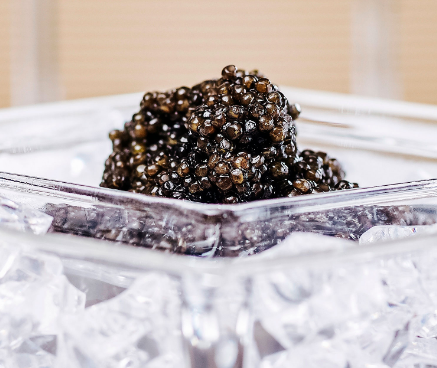
;1. Introduction
In the realm of luxury delicacies, caviar reigns supreme as the epitome of indulgence. This article aims to delve into the captivating world of caviar, specifically comparing the renowned Iranian caviar with its Russian counterpart. Join us on a journey to discover the unique characteristics and qualities that set these two culinary treasures apart.
2. What is Caviar?
Caviar is the roe (eggs) of sturgeon, a prehistoric fish found in the Caspian Sea and the Black Sea. These eggs are harvested and processed into a highly sought-after culinary delight that captivates the taste buds of connoisseurs around the globe.
3. Iranian Caviar
3.1 History
Iranian caviar holds a rich historical legacy, dating back centuries. The Caspian Sea, which borders Iran, has been a prime source of caviar production for millennia. Iranian caviar has garnered worldwide acclaim for its exceptional quality and flavor.
3.2 Types
Iranian caviar boasts a diverse range of types, each with its distinct characteristics. From the exquisite Beluga caviar, known for its large, luscious pearls, to the buttery and rich Osetra caviar, there is a variety to suit every discerning palate.
4. Russian Caviar
4.1 History
Russian caviar, like its Iranian counterpart, has a storied past deeply intertwined with the culture and heritage of the region. The Black Sea and the Caspian Sea have been the primary sources of Russian caviar, which has delighted epicureans for centuries.
4.2 Types
Russian caviar offers a tantalizing selection of types, each with its own allure. The iconic Ossetra caviar, with its nutty and creamy notes, and the Sevruga caviar, known for its robust and briny flavor, are just a couple of the many exquisite options available.
5. Differences
5.1 Flavor
When it comes to flavor, Iranian caviar and Russian caviar showcase distinct profiles. Iranian caviar is often described as buttery, nutty, and slightly sweet, with a long-lasting finish. In contrast, Russian caviar is renowned for its brininess, offering a more pronounced and savory taste.
5.2 Texture
Texture plays a vital role in the caviar experience. Iranian caviar is celebrated for its delicate, velvety texture, providing a luxurious sensation on the palate. On the other hand, Russian caviar tends to have a firmer texture, allowing the eggs to pop and release their flavors more assertively.
5.3 Price
Price is often a significant factor when comparing Iranian and Russian caviar. Iranian caviar, particularly the Beluga variety, is widely regarded as one of the most expensive types of caviar in the world. Its scarcity and exceptional quality contribute to its elevated price point. Russian caviar, while still luxurious, generally offers a more accessible range of options to cater to varying budgets.
5.4 Availability
Availability can also differ between Iranian and Russian caviar. Due to various factors, including regulations and conservation efforts, Iranian caviar has faced challenges in meeting global demand. As a result, it may be more limited in its availability compared to Russian caviar, which benefits from a more consistent supply.
6. Which is Better?
Determining which caviar is better ultimately boils down to personal preference. Both Iranian and Russian caviar have their own allure and distinctive qualities that appeal to different tastes. Iranian caviar is prized for its velvety texture and balanced flavor, while Russian caviar captivates with its brininess and robust taste. It is recommended to savor both varieties to truly appreciate their nuances and make an informed judgment based on individual preferences.
7. Conclusion
In the world of gourmet indulgence, Iranian caviar and Russian caviar stand as formidable contenders, each with its unique charm. The rich history, diverse types, and distinct characteristics of both caviars make them a delight for the senses. Whether you prefer the delicate allure of Iranian caviar or the bold flavors of Russian caviar, indulging in these culinary treasures promises an unforgettable experience that epitomizes luxury and refinement.
FAQs (Frequently Asked Questions)
1. Is caviar only made from sturgeon eggs?
Yes, caviar is exclusively derived from the eggs of sturgeon fish, specifically the Caspian Sea and Black Sea sturgeons.
2. Can caviar be enjoyed on its own or paired with other foods?
Caviar is often savored on its own, served on a blini or toast point. However, it can also be paired with various accompaniments such as crème fraîche, chopped onions, or even scrambled eggs for a decadent breakfast experience.
3. Are there any sustainable caviar options available?
Yes, sustainable caviar options are becoming more prevalent. Some producers are focusing on ethical and environmentally friendly practices to ensure the long-term viability of sturgeon populations.
4. How should caviar be stored?
Caviar should be stored in the coldest part of the refrigerator, ideally between 28-32°F (-2 to 0°C). It is essential to keep the container tightly sealed to maintain freshness and prevent any absorption of odors from other foods.
5. Can caviar be frozen?
Caviar is best enjoyed fresh, but it can be frozen if necessary. However, freezing can affect the texture, so it is recommended to consume thawed caviar immediately for the best experience.

